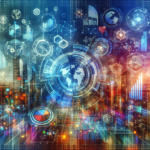The Dynamic Fusion of AI and Virtual Reality: Redefining Experiences Across Industries 🌐
Introduction: Sailing into the Future of Immersive Technologies
The dawn of Artificial Intelligence (AI) combined with Virtual Reality (VR) marks a significant milestone in technology, reshaping how we experience the digital realm. This captivating synergy is paving the way for transformative applications across various industries. From healthcare to entertainment, the integration of AI and VR is not merely enhancing experiences; it is revolutionizing them!
The Magic of AI in Immersive Environments
Imagine stepping into a virtual world so realistic that it feels tangible! With AI in VR, this dream is an evolving reality. Here’s how:
- Adaptive Environments: AI enables dynamic alterations in VR landscapes, tailoring them in real-time based on user interactions.
- Enhanced Realism: The integration of AI optimizes rendering techniques, resulting in breathtakingly detailed textures and models.
- Intelligent NPCs: Non-Player Characters (NPCs) are no longer just programmed figures; they now exhibit lifelike behaviors, enhancing gaming and simulation.
Key Technologies Behind the Fusion
Several advanced technologies fuel this convergence, enhancing the immersive quality of virtual experiences:
- Natural Language Processing (NLP): Facilitates voice commands, allowing users to interact intuitively with VR environments.
- Machine Learning: Studies user behavior to create personalized experiences and recommendations in real-time.
- Computer Vision: Recognizes user movements, fine-tuning VR interactions for a seamless experience.
Transformative Industries Benefiting from AI and VR
The impact of AI-enhanced VR stretches far beyond gaming. Let’s explore some sectors poised to benefit:
- Healthcare: VR simulations aid in surgical training, while AI analyzes patient data for personalized treatment plans.
- Education: Immersive learning environments powered by AI offer tailored educational experiences for students.
- Retail: Virtual shopping experiences allow consumers to try products virtually, guided by AI recommendations.
- Gaming: Enhanced gaming experiences with realistic graphics and intelligent NPCs ensure unrivaled engagement.
Examples of AI in Action within VR
Real-world applications exhibit the profound effects of AI in VR:
- Training Simulation: Pilots use VR for realistic flight training, where AI simulates various scenarios for hands-on experiences.
- Behavioral Therapy: AI-driven VR environments are being utilized to treat phobias and PTSD by creating controlled exposure scenarios.
- Fitness Apps: Interactive VR fitness platforms adapt workouts based on user performance and preferences, powered by AI analytics.
Challenges on the Horizon
The integration of AI and VR is not without its challenges. Addressing these concerns is vital for successful implementation:
- Privacy and Security: Ensuring user data protection is paramount. With AI’s ability to analyze behavior, safeguarding personal information must be prioritized.
- Technical Limitations: The demand for immense computing power can pose challenges, especially when integrating into mobile devices.
- Ethical Considerations: The biases in AI algorithms can lead to unfair experiences, underscoring the need for ethical AI deployment.
The Path Forward: Research and Collaboration
The future of AI and VR integration hinges on continued research and cooperative efforts among technologists, ethicists, and policymakers. Innovation and responsible adoption will unfold, nurturing a balanced ecosystem. Together, we can push the boundaries of what’s possible, creating enriched experiences that are immersive, personalized, and secure!
Future Trends Envisioned in AI-Driven VR
As AI and VR evolve, several trends are set to redefine the landscape further:
- AI-Powered Storytelling: Personalized narratives that adapt to user choices, enhancing engagement in entertainment and education.
- Mixed Reality Experiences: The synergy of virtual elements with real-world interactions, opening new horizons in training, gaming, and marketing.
- Hyper-Realistic Avatars: AI-driven avatars capable of mirroring human expressions and emotions, transforming social interactions in virtual spaces.
- Enhanced Multisensory Experiences: Integrating touch and smell to elevate immersion, making virtual environments feel more lifelike.
Conclusion: The Infinite Possibilities Await
The convergence of AI and VR is but the beginning of an exciting journey towards unparalleled immersive experiences. As these technologies develop, they promise to create a world where the boundary between the digital and physical continues to blur, bringing once-distant possibilities within reach. With research and ethical considerations guiding this progress, the future is indeed bright! 🚀




0 Comments